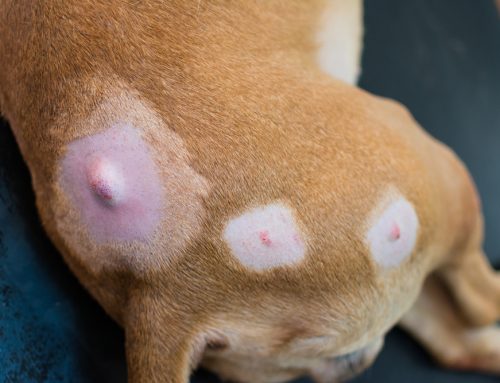Our four-legged companions fill our lives with joy, wet noses, and furry cuddles. Pet parents enjoy a symbiotic relationship with their furry pals and frequently share meal times, exercise activities, and sleeping spaces together—some of the many benefits to having a pet. However, sharing time with your pet should not include sharing and spreading hitchhiking pests. Parasites are common in pets who don’t receive regular veterinary care and can cause discomfort and disease. Our Guam Pet Hospital team wants to ensure your pet is healthy and protected from pesky parasites.
How does my pet become infected with parasites?
Parasites are organisms that benefit by living on or inside your pet. Any animal can become infected with parasites, although pets who do not receive regular parasite control have the greatest infection risk. Common ways your pet may become infected with parasites include:
- Eating other animals’ infected stool
- Reinfection from the pet’s own stool
- Eating raw meat or prey animals (e.g., rodents)
- Penetration through the skin or mouth
- Eating infected external parasites (e.g., fleas)
- Contact with other infected animals
- Infection passed from the mother cat or dog
- Walking through thick brush or wooded areas
Common external parasites in pets
Hitchhiking pests on your pet’s fur and skin are usually easy to spot. Several external parasites commonly affect pets, and some, like fleas, may also bite people. Common external parasites include:
- Fleas — Adult fleas are black, and no larger than a sesame seed. These parasites thrive in warm, humid weather, and move rapidly over your pet’s skin, causing extreme itchiness, and sores and scabs that may develop from excessive scratching. Fleas can also carry tapeworm larvae, which can cause infection when pets ingest fleas.
- Ticks — Pets who venture into shrubs and bushes and wooded areas are most at risk for infection from ticks. Ticks can attach to any part of your pet’s body, but are most commonly found on their neck, ears, paws, and the sides of their bodies. Ticks feed on your pet’s blood and can pass on a variety of diseases to your pet that can be deadly without treatment. Pets with ticks do not usually itch, but can develop skin irritation where the tick attaches.
- Ear mites — These mites typically cause a dark brown or black discharge in your pet’s ear. Your veterinarian can examine the discharge under a microscope to determine whether mites are present. Mites that infect your pet’s ear canal can cause excessive head shaking, scratching, and secondary infections.
- Mange mites — Sarcoptic (i.e., scabies) and demodectic mites are the two most common causes of mange in pets. Scabies are highly contagious and can cause intense itching, hair loss, and rash. Demodex mites are not highly contagious, and are most commonly found in dogs younger than 6 months. Pets with demodex mites are rarely itchy, but may have scaly skin patches and redness, especially around the eyes, mouth, legs, and torso. Our veterinarian will use a scrape sample of your pet’s skin to diagnose mange.
Common internal parasites in pets
Many internal parasites prefer to live in your pet’s gastrointestinal tract (GI) and may cause more serious illnesses, including malnutrition, anemia, and sometimes pneumonia. Some pet parasites can also affect people who share their environment with an infected pet. Common intestinal parasites include:
- Roundworms — These worms are the most common intestinal parasite in dogs and cats worldwide, and can be transmitted when pets ingest infected feces.
- Hookworms — These are the second most common parasite found in a dog’s GI tract, where they bite into the intestinal lining to feed on blood, and can cause life-threatening anemia. Young pets are especially at risk for serious illness from these parasites. Hookworms are rarely found in cats.
- Whipworms — Like hookworms, these parasites bury into the lining of your pet’s GI tract and feed on their blood. Whipworms are generally not as harmful, although they can still cause diarrhea or weight loss.
- Tapeworms — These flat parasites live primarily in your pet’s small intestine and survive by stealing nutrients. Egg sac and parasite larva that resemble a grain of rice can be found beneath your pet’s tail or in their stool.
Although most intestinal parasites are not visible, ensure you monitor your pet for infection signs. Intestinal parasites can lead to serious illness, so ensure you bring your pet for a veterinary exam if they show any of the following signs:
- Vomiting worms
- Diarrhea
- Weight loss
- Dull fur coat
- Worms in stool or bedding
- Lethargy
Parasite prevention in pets

Regular preventive care visits combined with monthly prescription parasite control from our veterinary team are the best insurance against infection and associated illness in your pet. We recommend Simparica Trio for dogs, which protects against fleas, ticks, heartworms, and intestinal parasites. For cats, we will recommend the products that best fit your feline friend’s lifestyle. Always let our veterinarian know if you have given your pet any over-the-counter parasite preventives. Other prevention tips include:
- Checking your pet for ticks after walks or hikes in heavily wooded areas
- Removing fecal material to prevent infection and environmental contamination
- Setting a recurring monthly reminder on your calendar about your pet’s parasite preventive
- Never give a dog parasite prevention product to your cat, and vice versa
Call our Guam Pet Hospital office if you have any questions about parasite prevention in your pet, or to schedule a preventive care exam and parasite testing.








Leave A Comment